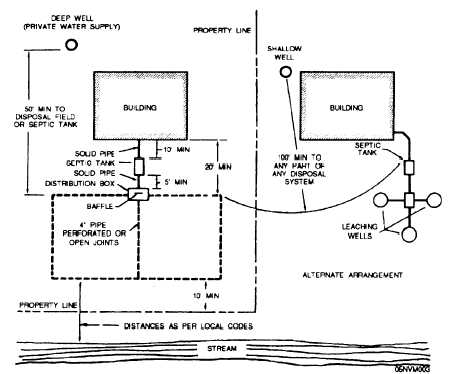material removed contains fresh or partially digested sewage solids. It must be disposed of without endangering public health. Disposal through manholes in the nearest sewer system, as approved by local authorities, or burial in shallow furrows on open land is recommended. A diaphragm type of sludge pump is best suited for removing the content of the tank. The contents should be transported in a watertight, closed container.
When installing a septic tank system for sewage treatment, you must take into consideration the location with respect to wells or other sources of water supply, topography, water table, soil characteristics, area available, and maximum building occupancy. Building occupancy is a key factor in determining tank size. Table 10-15 shows common sewage uses based on type of facility and gallons per person per day of usage.
The physical location of a septic tank in relation to wells must be no closer than 100 feet from a shallow well and no closer than 50 feet from a deep well. In general, a shallow well is less than 100 feet in depth and a deep well is more than 100 feet in depth. Figure 10-4 shows a typical septic tank system layout with minimum distances noted. Keep in mind that septic tanks, cesspools, and leaching fields must be located downhill from any water source.
CESSPOOLS
Sewage from private dwellings and farmhouses in outlying areas may discharge into cesspools if a common sewerage system is not available. Cesspools are usually dry-laid masonry or brick-lined wells without any masonry at the bottom. The sewage flows into them and leaches out into the soil. Floating solids collect at the top and settling solids collect at the bottom of the well. The leaching capacity of the well is exhausted when the solids accumulate and clog the soil. The use of chemicals is not recommended

Figure 10-4. - Minimum distance for location of components of a private sewage disposal system.
Continue Reading